Country Information - Islamic Republic of Pakistan اسلامی جمہوریۂ پاکستان (PART 05)
Communication NetworkAIR LINKS AND SERVICES
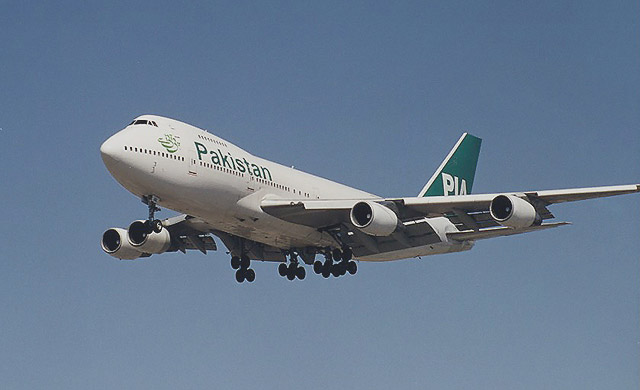
At the time of independence of Pakistan in 1947, there was no air service available in the country for passenger traveling, specially so to link the two part of the then united Pakistan, i.e. West and the East Pakistan, separated by almost a stretch of 1000 miles by India. It was sometime in 1951 that serious thinking underway to have a national flag carrier airline. Till then as a stop gap arrangement, Orient Airways started operating to provide air services on a small scale. In 1951, the then government established Pakistan International Airlines (PIA), and on 25 May ordered three Lockheed L-1049C Super Constellation four-engined aircraft. The newly born PIA flew its first service with the Super Constellation on 7th June 1954 on the route linking Karachi and Dacca (East Pakistan, now Bangladesh), which were the main cities of the country's western and eastern halves. On 1 February 1955 the airline flew its first international service, between Karachi and London via Cairo. From then on the lone national carrier grew and soon became one of the best airlines in the world. From turbo props, it went on to Boeing 707s/720Bs, Trident, DC-10, Boeing 747s and now operates Boeing 777s and many versions of Airbus.
PIA continued to dominate the domestic scene of Pakistan being the only airlines, carries approximately 70 percent of domestic passengers and almost all domestic freight traffic. However, in the early nineties there was a major growth in the Pakistani aviation market with four new private airlines launching operations. The airline did very well to compete with the well established flag carrier, PIA which was controlled by the government. However, this was not to last as the UN placed economic sanctions on Pakistan and its neighbour, India that caused the airline market to suffer. It caused two of the four airlines to file for bankruptcy and liquidate their assets. The airline industry remained quite stable with PIA developing a strong hold on the international and domestic market for many years. It was not until the early 21st century that the industry started to pick up again that allowed the entry of a new carrier in the market, Air Blue which launched operations with new state of the art aircraft. As of now, many private companies namely Shaheen Airlines, Aero Asia and Air Blue are competing PIA both in domestic and international routes.
Shaheen Airlines - One of the privately operated airlines in Pakistan (Photo Courtesy: Pervez 183A )
Beside these major airlines, some domestic airlines are also operating on smaller scale, like the Askari Aviation, AST Pakistan Airways, Jahangir Siddiqui Charter JS Air (Private) Limited, Pakistan Aviators & Aviation, Royal Airlines, Schon Air and Princely Jets.
Pakistan is maintaining a total of 36 operational number of big, medium and small sized airports - Quaid-e-Azam International Airport (Karachi), Allama Iqbal Internationa Airport (Lahore), Benazir International airport (Rawalpindi) are the three major airports for domestic and international airlines. Quetta and Peshawar also have airports linking Iran and Afghanistan. Other airports include Sukkur, Jacobababd, Pasni, Jiwani, Gwader, Ormara, Hyderabad, Faisalabad, Multan, Skardu, Gilgit and Chitral. The last three airports are located in the northern areas of Pakistan, where flights are badly affected due to severe weather conditions.
Ports
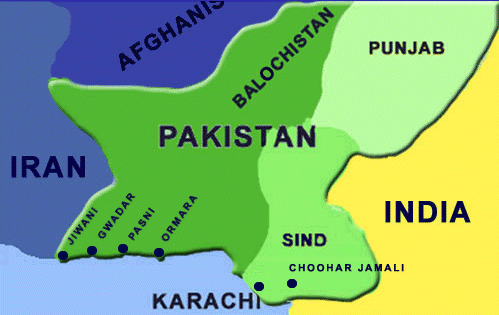
Pakistan shares a 1,200 kilometres long coast line with the Arabian Sea - a mid sea which joins the the strategic oil line of Persian Gulf with the Indian Ocean. On it lie the Karachi Port which has been serving this part of the erstwhile Indian subcontinent and later Pakistan on its creation in 1947. However, owing to the growing needs of the country, there was a need to develop other smaller coastal ports into major cargo handling ports. Beside Karachi, Pasni, Jiwani, Gadani, Ormara and Gwadar are other ports which are being developed into world class ship handling centres. Of these Gwadar is the latest development, which is almost completed and recently in December 2008, it has started handling shipping operations with the arrival of three urea laded ships.
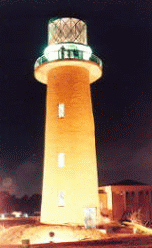
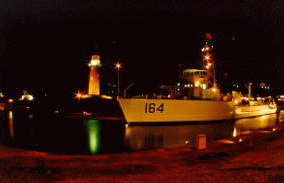
Karachi Port and Light House
Karachi Port: Karachi Port is the hub of Pakistan's entire economic activities as 98 per cent of the entire foreign trade is conducted through this port. Read more about the history of Karachi Port (Wikipedia). As such Karachi Port is being modernized at a total cost of Rs. 5 billion including World Bank loan of US $ 91.4 million. The Government has increased emphasis on an early completion of the entire scheme. As a result the following projects have already become functional:-
-
OP-V:- OP-V has been constructed at a cost of Rs. 510 million with an annual handling capacity of 6 to 8 million tons liquid cargo. The project has been in operation since April, 1994.
-
Circular Road:- To solve the problem of traffic congestion around Port area and central city areas of Karachi Metropolitan Corporation, the Government has given go ahead signal for construction of a Circular Road comprising Southern By-pass, Jinnah Bridge (Phase-II) and Northern By-pass at an estimated cost of Rs. 1353 million. The first phase of the project has been completed in December, 1997.
-
Reconstruction/Rehabilitation of Berths No.5-10:- To enable Karachi Port to handle increasing volume of cargo, the Government has directed to reconstruct/rehabilitate the Berths No. 5-10 at an estimated cost of US $ 60 million within the next 2 years.
-
Container Terminals.- In order to modernize cargo handling at Karachi Port, the Government has directed KPT to set up another Container Terminal at West Wharf (Berths NO.22-24) through private sector at an estimated cost of US $ 75 million.
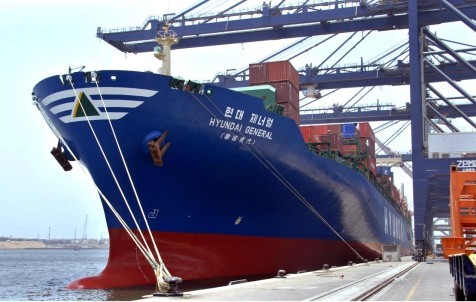
| On April 5, 2009, the first super cargo ship ( pictured above) carrying 5000 containers arrived in Pakistan through the newly dredged 11 km long channel berthed in a new berth which has been dredged down to a depth of 14m ( The berth used to be 11.3 m deep before current development ). |
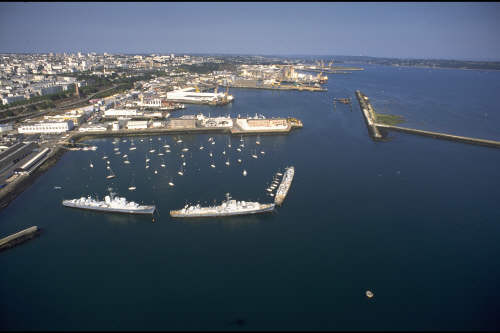
Port Bin Qasim
Port Muhammad Bin Qasim
With the coming up of the Steel Mills near Karachi and to meet the increasing demand of coal, it was decided to construct a sea port some 35 kilometres west of Karachi. It was constructed in the late 1970s and named after the Muslim general Muhammad bin Qasim who captured the area around 712 A.D. The port was developed close to the Pakistan Steel Mills complex near the Indus River delta. Port Qasim is Pakistan's second busiest port, handling about 35% of the nation's cargo (17 million tons per annum). It is located in an old channel of the Indus River at a distance of 35 kilometres east of Karachi city centre. The total area of the port comprises 1,000 acres (4 km²) with an adjacent 11,000 acre (45 km²) industrial estate. The approach to the port is along a 45-kilometre long Navigation Channel which provides safe navigation for vessels up to 75,000 DWT. The geographic position of the Port places it in close proximity to major shipping routes. One of it's major advantages is the proximity to national transport facilities - 15 kilometres from the Pakistan National Highway, 14 kilometres from the National Railway network through six railway tracks located immediately behind the berths and 22 kilometres from Jinnah International Airport.

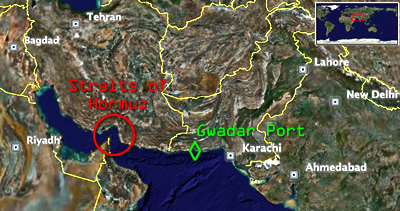
Gwadar Deep Sea Port: Gwadar was once a fishing village on the Arabian Sea coast in Balochistan province and some 72 kilometres from the Iranian border. It is situated about 400km from the Strait of Hormuz, a major conduit for global oil supplies. More than 13 million bbl/d of oil pass through the Strait. It is strategically located between three increasingly important regions: the oil-rich Middle East, heavily populated South Asia and the economically emerging and resource-laden region of Central Asia. The present town of Gwadar, Pakistan, lies on the Arabian Sea coast about 30 miles (48 km) to the east of Gwadar Bay. Gwadar's location and history have given it a unique blend of cultures. The Arabic influence upon Gwadar is strong as a consequence of the Omani era and the close proximity of other Arab-majority regions. The legacy of the Omani slave trade is observed in the population by the presence of residents which can trace their descent from the African slaves who were trafficked through the town (en route to destinations in the Muslim Far East. The area also has a remarkable religious diversity, being home to not only Sunni Muslims, but also to groups of Christians, Hindus, Parsis, and various minorities.
Pakistan identified Gwadar as a port site in 1964. However, it was only in 2001 that significant steps were taken with the help of Chinese assistance in the construction and development of the deep-sea port. The total cost of the project is estimated at US$1.16 billion, of which China has contributed about $198 million for the first phase for construction of three multi-purpose ship berths. China has also invested another $200 million toward building a highway connecting Gwadar port with Karachi.
Gwader Sea Port and the Zaver Pearl Continental Hotel situated on a cliff (Koh-e-Batil) - Photos courtesy: Autumn Sun and Autumn Colours
The 45,000 acres Gwadar master plan encompasses development of an airport, industrial zones, export processing zones, beach development, resorts, housing facilities and all civic amenities over the next 50 years. The over $2 billion Gwadar project - which strategic analysts call "a pearl in the Pakistani waters" will allow berthing facilities to many a CAR countries and even China, which is assisting Pakistan in a big way to develop this port. The completion of Gwadar port would make it the deepest port of Pakistan and a trans-shipment port for the region. This is Pakistan's largest infrastructure project since independence. Funds from non-resident Pakistanis, especially those working in the Gulf, have come in. With Chinese help, it has been completed in five years, which is really fast. Read More ...
In 2007, the government of Pakistan handed over port operations to PSA Singapore for 25 years, and gave it the status of a Tax Free Port for the following 40 years. There is also money invested into the port by the People's Republic of China. The strategic PRC plan to be engaged in many places along oil and gas roads is evident.
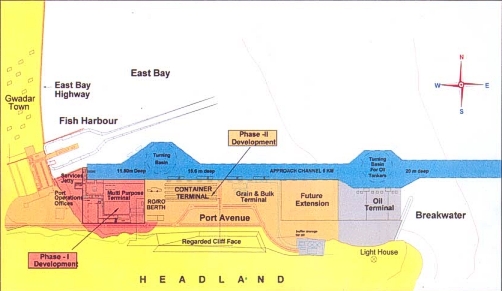
To accommodate the tourists and investors from all over the world, Zaver Pearl Continental Hotel Gwadar, a Five Star Hotel situated on a dominating cliff (Koh-e-Batil), overlooking the port, city and surrounded by azure Arabian waters has been built. The hotel is equipped with all those features which are mark of the Hashoo Group. Beside 120 guest rooms, the hotel has Business center with three secretarial offices and two meeting rooms, fully equipped with modern communication and audio visual equipments, dinning room / bar facility for 55 guests.
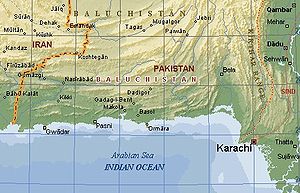
Ormara
Ormara is a small port located on the Makran coastline along the Arabian Sea in Balochistan province of Pakistan. It is located 450 kilometres west of Karachi, and east of coastal village Pasni. Jinnah naval base of Pakistan Navy is also located at Ormara. Ormara also has a small airport for landing of short run aircraft like the Fokker. Ormara is an old coastal town. Its historical routes are linked with Alexander the Great, who stayed here with his army for a few days on his way back from Indus region after conquering the lands of Sindh, Panjab and the NWFP regions of modern day Pakistan which he joined to his expanding Hellenic empire, in 325-27 BC. One of his generals "Ormoz" died here and the present day Ormara was named after him. For a few centuries, Ormara remained a battle field between the Baloch Sardar (local feudal) and foreign aggressors. Before independence, it was part of the state of Las Bela and afterward it became part of Makran Division. Being an isolated town, it remained undeveloped, however with the naval presence around, life has taken a positive change for the locals with many local industries and the resultant increase in jobs available for the locals. It has a population of about forty thousand people and still offers a traditional look at how the ancients lived. Most residents make their livelihood from fishing; a few of them also work in Middle Eastern countries. Ormara has witnessed considerable growth in recent years especially with the foundation of the Makran coastal highway, which integrated the area more with the mainstream Pakistani economy and major urban centres allowing for easier transport of goods, commerce and people.
Pasni
Pasni is a medium-sized town and a fishing port in along the Makran coastline Balochistan, Pakistan. It is located about 300 km from Karachi. The town houses a modern fish harbour and Port of Pasni, with fishing being the main occupation of the town dwellers. Frozen catch is also sent to Turbat and Karachi for sale in the larger markets. A joint-user airfield is shared by Pakistan Air Force (PAF), Pakistan Navy and civil aviation. PAF as well as PN-Aviation operational facilities are housed nearby. Daily commercial flights link the town with Karachi. In 2008, the government approved the construction of Shadi Kaur storage dam near Pasni, which is expected to alleviate some of the power deficiency of the region. Administratively, Pasni is the headquarters of the Pasni sub-division of Gwadar district that includes Pasni and Ormara Tehsils (tehsil - county) as well as Astola Island which lies 40km ESE of Pasni, in the Arabian Sea. The city of Pasni is itself administratively subdivided into two Union Councils.
Jiwani
Jiwani - a small fishing harbour, holds strategic importance in the region, located immediately adjacent to the shipping lanes to and from the Persian Gulf. This is the main reason that the town hosts a small naval base and an airport with a 5,500-foot runway. Jiwani is located at the eastern end of Gwadar Bay, which is shared between Iran and Pakistan. The area around the bay includes an important mangrove forest extending across the international border, and is an important habitat for a wide variety of wildlife, especially the endangered Olive Ridley and Green Turtles. Being free from pollution, Jiwani is reminiscent of a South Sea island, with vast stretches of sandy beaches giving onto the clean, clear green waters of the Arabian Sea. For the same reason, Jiwani is rich in biodiversity. Recently, WWF-Pakistan established the Jiwani Conservation and Information Centre (JCIC). The aim is to contribute towards the conservation of biodiversity in the area, through information dissemination.
With the extension of the Makran Coastal Highway from Gwadar, Jiwani is a place to be seen especially by those who are interested in observing history more closely. Jiwani has a small airport located 10 km away from the city centre. It is not a major airport of Pakistan but has weekly flights connecting it with Gwadar, Pasni and Karachi.
Jiwani has been used World War II as allied base and remains of same base are available. Visiting the barracks area of the base used during World War 2 reveals many handwritten small stories and name of Allied Pilots. There is another story linked to Jiwani and that is Queen Victoria planned to visit the area to watch sunset and a hut which is now known as "Victoria Hut" was built for this purpose. Whether Queen Victoria visited or not but the Victoria hut is still being maintained by Pakistan Coast Guards.
PAKISTAN RAILWAYS
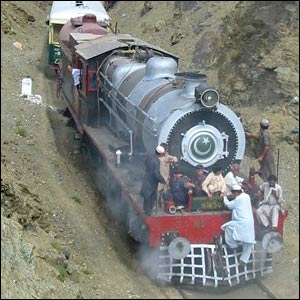
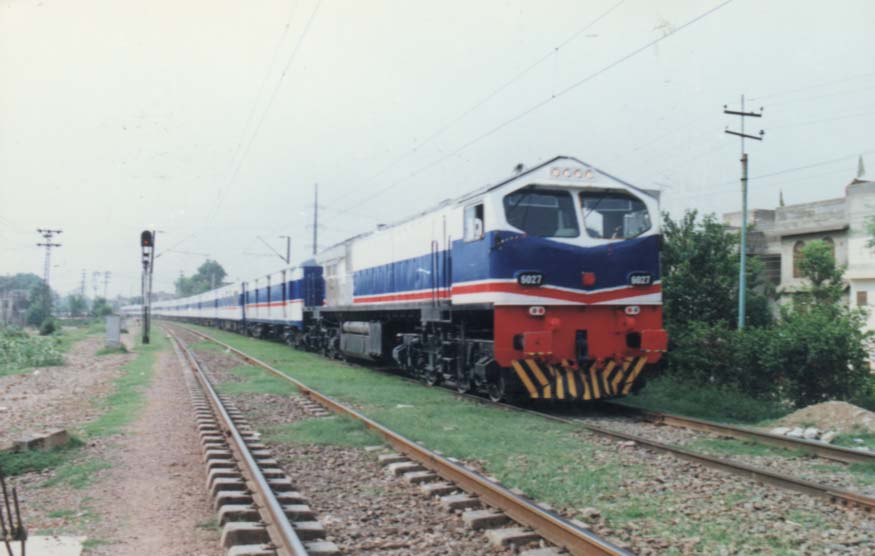
From Steam Engines to Fast Track Trains
Stretched over 8,800 kilometres, Pakistan's railway network constitutes the backbone of its transportation system and plays a pivotal role in the country's economy. Pakistan Railways provides an important mode of Transportation in the farthest corners of the country and brings them closer for Business, sight seeing, pilgrimage and education. It has been a great integrating force and forms the life line of the country by catering to its needs for large scale movement of people and freight.
Bolan Express - Photo Courtesy Commoner28th
The possibility of Karachi as a sea port was first felt in the mid of 19th century and Sir Henry Edward Frere who was appointed Commissioner of Sind after its annexation with Bombay in 1847 sought permission from Lord Dalhousie to begin survey of sea port. He also initiated the survey for Railway line in 1858 . It was proposed that a railway line from Karachi City to Kotri, steam navigation up the Indus /Chenab up to Multan and from there an other railway to Lahore and beyond be constructed. Sir Bartle Frere, who was the then Commissioner of Scinde (Sindh) did the ground breaking of the project on April 29, 1858. The ceremony included him pushing a wheel-barrow full of construction material at the site of a railway embankment in Karachi. In 1859, two small stretches of Railway Line were opened in Karachi. One of this track section still exists while the other one has been uprooted.
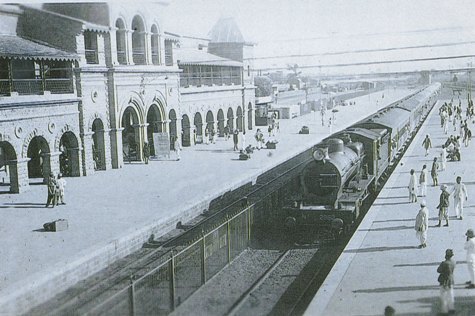
A year 1900 view of the Karachi-Kemari Train
Thus, it was on 13th May,1861 that first railway line was opened for public traffic between Karachi City and Kotri, the distance of 105 miles. The line between Karachi City and Keamari was opened on 16.6.1889.By 1897 the line from Keamari to Kotri was doubled. The 4 sections i.e. Scinde railways, Indian Flotilla company Punjab railway and Delhi railways working in a single company were later on amalgamated into Scinde, Punjab & Delhi railways company and was purchased by the Secretary of State for India in 1885 and in January, 1886 it was named North Western State Railways which was later on renamed as North Western Railways. Read more about further developments on introduction of railways in Scind (Sindh).
The railway line from Peshawar to Karachi closely follows Alexander's line of march through the Hindu Kush to the sea. Different sections on existing main line from Peshawar to Lahore and Multan and branch lines were constructed in the last quarter of 19th century and early years of 20th century. At the time of partition, North Western Railway's 1847 route mile was transferred to India leaving route miles 5048 to Pakistan. In 1954 The railway line was extended to Mardan and Charsada section and in 1956 Jacababad-Kashmore 2'-6'' line was converted into broad gauge. Kot Adu-Kashmore line was constructed between 1969 to 1973 providing an alternate route from Karachi to up country.
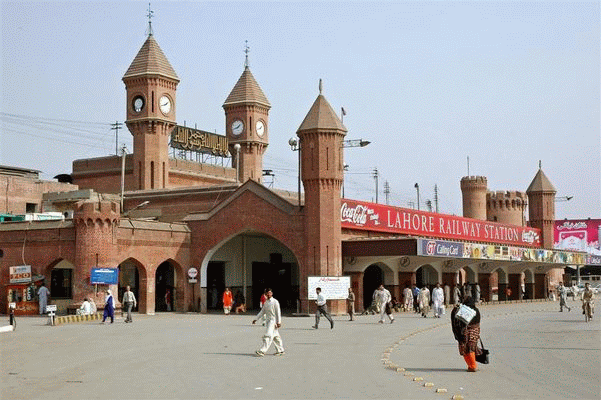
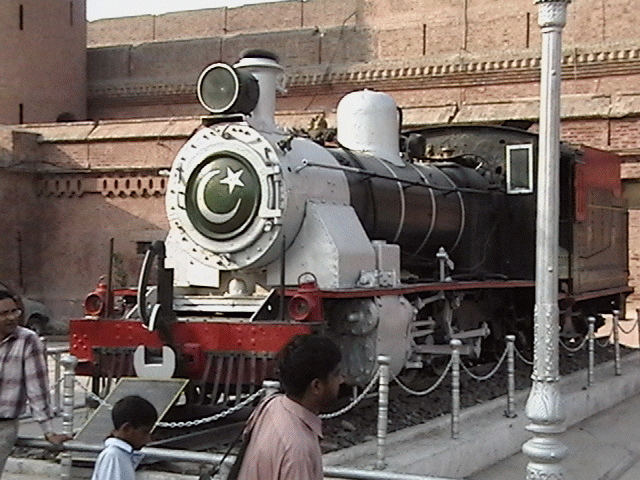
Left: Lahore Railway Station (stands as it was built by the British) - Right: The Steam Engine finally resting outside Lahore Railway Station
Today, Pakistan Railway comprises 8,775 route km, 781 stations and 42 trains halts. It has a fleet of 546 diesel electric locomotives, 25,815 wagons and 2,099 passenger coaches. Pakistan Railways is multi system and operates on three gauges, i.e. broad gauge, meter-gauge and narrow gauge. Maintenance is provided by three major locomotive workshops and thirty-five smaller workshops. Signaling facilities at important stations are track circulated within interlocking limits. Most routes have VHF radio coverage for communication between train dispatchers and trains. Telephone Communication is over wire lines and microwave. Freight traffic during the past five years has averaged 5-6 million tones per annum. It was 15 million tones per annum in the 1960 but trucking has steadily taken over the freight market. The volume of freight traffic in 1995/96 was approximately 5.1 billion-km. PR carried about 145 million passengers per annum in the 1970 but during the past five years, it has dropped to 70 million per annum. However the average distance per kilometre has increased from 80 km in the 70's to about 260 km today.
Balochistan Express en' route to Quetta (left) Over Hauling of a Burnt Engine (right - read inset below) - Photos Courtesy Commoner28th
| There is something special about the Engine hauling this train. After the violent riots on account of tragic murder of Mohtarma Benazir Bhutto on 27th Dec 2007, this engine was pulling the fateful Chiltan Express, burnt near Bakhsha Pur Station. The engine was declared scrap but the railway workers at the diesel shop Quetta, without any extra resource rehabilitated the engine within just 10 days, saving the country almost 60 Million PKR. |
Due to resource constraints, though, Pakistan Railways has fallen behind in routine and periodic maintenance, leading to deterioration of the entire infrastructure. Tracks are in poor condition, necessitating speed restrictions that result in undue delays and high transportation costs. Obsolete signaling and telecommunications equipment compromise travel safety and efficiency, and railway workshops lack the modern machinery needed to turn out enough spare parts. These deficiencies have led many businesses to shift their goods traffic from the railways to the country's already overtaxed road network. This loan will support an extensive scheme to modernize and increase the carrying capacity of the rail network. The project will address the various shortfalls by re-commissioning locomotives that are no longer fit for use, renovating or purchasing new rolling stock, in particular freight and high capacity oil-tank wagons, restoring severely deteriorated stretches of track, and modernizing plant and machinery at a number of workshops. These efforts will serve to expand the network's carrying capacity, and improve speed and safety standards.
Modernization Activities: The major emphasis of Pakistan Railways has been on the replacement of overage assets. Due to resource constraint, however, it is now engaged in modernizing certain areas as best as it can. These include the following:-
-
To ensure more comfortable journey it has been decided to manufacture only lower class air-conditioned coaches in future.
-
All second class coaches are being provided with cushioned seats.
-
Reservation work has been computerized on modern lines at Lahore and Karachi stations; the system's two major reservation centres. Computerization of reservation offices of Peshawar, Rawalpindi, Faisalabad, Multan and Hyderabad is in progress and is likely to be commissioned shortly. The steps are now underway to link these stations with other major railway stations.
-
Closed circuit televisions have been introduced at Lahore, Karachi, Multan and Faisalabad railway stations. This entertainment is being extended to Sukkur, Rawalpindi and Peshawar stations in the next phase. Subak Kharam and Shalimar trains have also been provided with closed circuit televisions and this system is being provided in Subak Raftar also.
-
Public address system is being provided in Subak Raftar, Subak Kharam, Tezgam and Khyber Mail trains.
-
Modernization of Karachi, Quetta, Hyderabad, Multan, Lahore, Faisalabad, Rawalpindi and Peshawar Railway stations, removal of hindrances on railway platforms and upgradation of approach roads are being carried out.
-
Private Sector is being encouraged to participate in the activities of the system. As a first step, ticket selling and ticket checking on Lahore-Faisalabad and Lahore-Narowal-Sialkot Sections have been privatized.
-
Feasibility study for a high-speed track is in hand.
Development Schemes: The Pakistan Railways has proposed major replacement and rehabilitation schemes for the forthcoming five year plan. An amount of Rs. 40 billion has been allocated for ongoing and new works. The major physical components which would be completed during the Plan period includes:
-
Doubling of track from Lodhran to Peshawar (800 Km) to ensure sustained improvement in the turn round time of rolling stock and motive power;
-
Manufacture of 51 locomotives;
-
Rehabilitation of 101 diesel electric locomotives;
-
Manufacture of 175 new design light-weight passenger coaches;
-
Equipping 7000 wagons with roller bearing;
-
Revamping of 14 electric locomotives;
-
Procurement of 1400 high capacity wagons;
-
Procurement of 50 wagon movers;
-
Introduction of Management Information System;
-
Improvement and Rehabilitation of track to cater for high speeds;
-
Telecommunication and Signaling Network on main and important branch lines.
Today, plans are afoot to introduce bullet-train type train service between Karachi and Lahore. Although a gigantic project for countries like Pakistan, but every new idea starts from a dream and this dream may not take long to materialize.
PAKISTAN TELECOM NETWORK
For years, the land lined telephones of Pakistan Tele Communication was the mainstay of keeping in touch with each other. The seeking of a new connection was a nightmare and there was a time that people joked that if a father applied for a telephone, his son may get it when he grew up. We lived that way for long till the mobile telephone was introduced and Paktel became the first company to introduce this modern technology at an exorbitant price. But soon others came in and today the mobile phones are used by people on cycles, at a butcher's shop or even the plumber has it. The land lines - no one really cares anymore. And the fast growing mobile phone network had its effects on the age old monopoly of the PTCL, and finally the PTCL has been part privatized. The new management is already gearing up to take on the new rivals. The company plans to add 2.4 million lines by June, increasing its capacity by 50%. And over the past year, PTCL has cut rates twice, though new entrants have proposed prices that are even lower.
Today a dozens of companies offer competitive packages to choose from and the market is flooded with foreign mobile phones. One can buy a second set for as low as Rs. 1000 or as high as ..... and today Pakistan is one of the fastest-growing cellular markets in South East Asia. Companies from as far away as Norway have been tempted by Pakistan and its population of 140 million. Since July, 2003, regulators have handed out more than 200 fixed, mobile, and long-distance licenses to some 50 companies. Although there will surely be a shakeout with so many new entrants, officials believe operators will pour as much as $8 billion into networks and equipment over the next five years, compared with just $1.5 billion since 1999. Karachi-based TeleCard Ltd., for instance, in January launched a $200 million fixed-wireless network, and expects to have 2 million subscribers within three years. Plans are also afoot for grant of licenses for 3G.
The internet usage has also multiplied with the introduction of DSL and WiMax services. The wireless telephones have enabled subscribers in remote areas to contact the mainstream usage as well (the PTCL V-Phone and Wateen). WiMAX in Pakistan emerged commercially with the launch of Wateen in August 2007. And now another strong competitor Mobilink has come up with its WiMAX brand 'Infinity" and now it looks like the competition will soon elevate with Wi-tribe and TeleCard entering the WiMAX service race in Pakistan. Wi-tribe is a joint venture of Qatar Telecom (Qtel) and A A Turki Corporation for Trading and Contracting (ATCO) in partnership with Clearwire. Wi-tribe is already offering services in Jordan and in Pakistan it has emerged out of the acquisition of majority stake in Burraq Telecom that occurred more than a year ago. They plan to showcase the real world benefits of Wireless Broadband to Internet community in Pakistan. Motorola has signed a multi-year WiMAX contract with wi-tribe Pakistan limited. Motorola has commenced deploying wi-tribe's WiMAX network in the 3.5GHz spectrum. Commercial launch is expected during 2009. The banking sector has also been benefitted from the advancement in telcom sector and many banks are providing e-banking facilities to their customers.
Pakistan Telecommunication Corporation (PTC) took over operations and functions from Pakistan Telephone and Telegraph Department under Pakistan Telecommunication Corporation Act 1991. This coincided with the Government's competitive policy, encouraging private sector participation and resulting in award of licenses for cellular, card-operated pay-phones, paging and, lately, data communication services. In view of the growing size of the Telecom industry in Pakistan, the Pakistan Telecommunication Ordinance 1994, established the primary regulatory framework for the telecommunication industry including the establishment of an authority. Thereafter, Telecommunication (Re-Organization) Act no XVII was promulgated in 1996 that aimed to reorganize the telecom sector of Pakistan. Under Telecom Reorganization Act 1996, Pakistan Telecommunication Authority (PTA) was established to regulate the establishment, operation and maintenance of telecommunication systems, and the provision of telecom services.
There were also plans to launch a Pakistani satellite based on very small aperture earth stations, which would provide nationwide coverage for domestic telecommunications. The number of telephone connections increased from 461,000 in June 1984 to 1.6 million in March 1993, when the government announced that the Pakistan Telecommunications Corporation would be privatized. A new entity, the National Telecommunications Network, was planned to assume responsibility for the government's own network. Radio and television are dominated by government corporations. The Pakistan Broadcasting Corporation (PBC) has a monopoly on radio broadcasting. In March 1992, there were 705,000 licensed radios, but the actual number of radios in use was estimated at 10 million. The PBC operates twenty-four medium-wave and three short-wave transmitters for its domestic programs and two medium-wave and eight short-wave transmitters for its external service. There are six networks for domestic service--one national network and the five regional networks for Balochistan, the Islamabad Capital Territory, the North-West Frontier Province, the Northern Areas, Punjab, and Sindh. The external service broadcasts in fifteen languages--Arabic, Burmese, Bengali, Dari, English, Farsi, French, Gujarati, Hindi, Indonesian, Swahili, Tamil, Turkmen, Turkish, and Urdu. An important target audience is Pakistanis working in the Middle East. Azad Kashmir Radio, a separate government-run organization, broadcasts in Azad Kashmir.
In early 1994, the government-controlled Pakistan Television Corporation (PTV) carried programs produced in five centers-- Islamabad, Karachi, Lahore, Peshawar, and Quetta. Programming comes under the purview of the Ministry of Information and Broadcasting, and goals include providing wholesome entertainment, promoting national solidarity, and projecting an Islamic way of life. In November 1992, PTV began broadcasting on a second channel made possible by Japanese financing and technology. This channel is intended mainly for educational purposes. A commercial station was also established in the early 1990s and provides competition for PTV. In 1993 it was estimated that there were over 2 million television sets, and the number is expected to climb steeply in the 1990s. The main PTV channel is capable of reaching 87 percent of the population, while the second channel is accessible to 56 percent of the population. Now there are dozens of private channels, both based in Pakistan and Dubai providing 25 hours news and entertainment programme.
The country today has three submarine cables linking Karachi with Southeast Asia, Europe and North America named as SWM3, SMW4 and TWA, first two with the PTCL and the third with a private operator. The total Internet bandwidth to the country stands at around 18 gigabytes, growing at around 45% every year for the last three years.
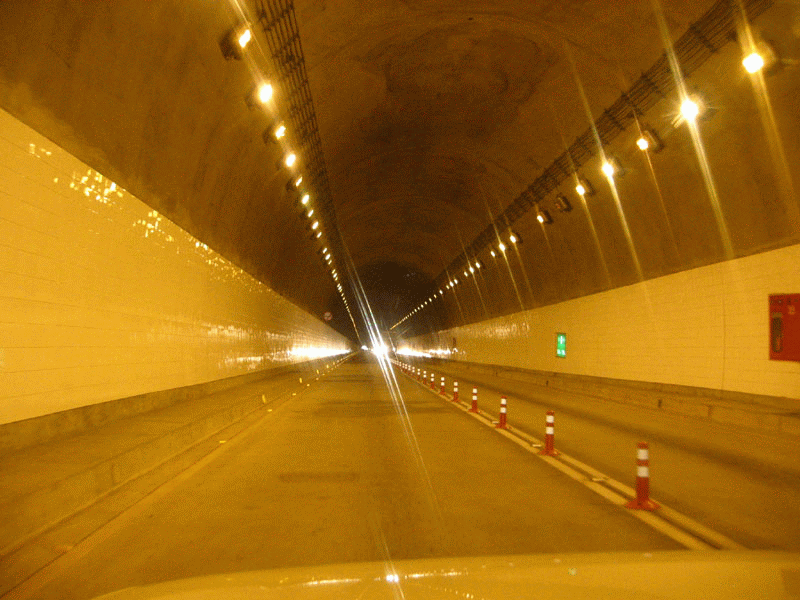
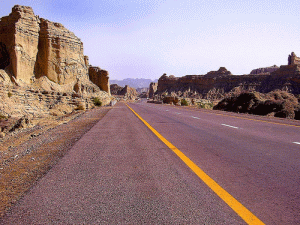
ROAD NETWORK OF PAKISTAN
No matter how advanced the railways or air services are, roads continue to be the prime source of major traffic around the world. The same holds true in case of Pakistan as well. Although, the condition of road network is not comparable with those of developed countries, but in the region, these are said to be quite adequate despite bumps and cracks. In the past 20 years, there has been a major stress on development of the road infrastructure. The first major highway of any consequence was the Super Highway that was build in President Ayub's era, joining Karachi and Hyderabad in the Sind Province. Then a major break through came when the Karakoram Highway was constructed with the assistance of China, connecting Pakistan and China through one of the most rugged mountains of the world. At Khunjrab Top, the road rose to be the highest in the world. Then came the motorway ear in the 90s when Lahore-Islamabad motorway was completed with the assistance and technical expertise of the Koreans. Since then, motorway netwqrk has extended to Peshawar, Faisalabad and plans are under way to connect Multan and Karachi.
In other words, road transport is the backbone of Pakistan's transport system. The 9,574 km long National Highway and Motorway network - which is 3.65 percent of the total road network - carries 80 percent of Pakistan's total traffic. Over the past ten years, road traffic – both passenger and freight - has grown significantly faster than the national economy. Currently, it is accounting for 91 percent of national passenger traffic and 96 percent of freight. However, over half the national highways network is in poor condition, and the road safety record is poor. The country's truck fleet is mostly made up of obsolete, underpowered, and polluting vehicles, and trucks are often grossly overloaded. Truck operating speeds on the main corridors are only 40 – 50 kph for container traffic, half of the truck speeds in Europe. For trucks carrying bulk cargoes, the journeys take 3-4 times longer than in Europe.
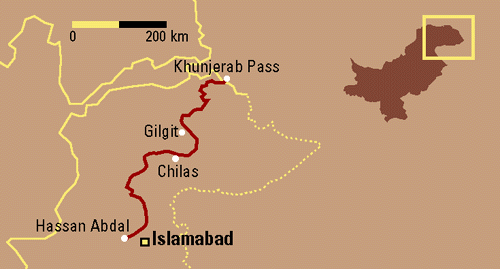 The Karakoram Highway: The 1300 kilometres (800 miles) long KKH, or the N-5, originates from Hassan Abdal, a place some 45 kilometres from Islamabad on the Islamabad - Peshawar Highway, goes through Abbotabad, Manshera, crosses the River Indus at Thakot, on to Gilgit (through Besham, Pattan and Sazin) and then to Chilas, Hunza and Sost before crossing the Khunjerab Pass at the height of some 4800 metres (15,750ft) - the Zero Point between Pakistan and China. It then enters the high Central Asian plateau before winding down through the Pamirs to Kashgar, at the western edge of the Taklamakan Desert. It is a marvel of human endurance, ingenuity and determination. Both Pakistani and Chinese workers and engineers worked day and night over some of the most formidable and inaccessible mountain ranges of the world, with deep gorges and torrential Indus running along the track with its full might. The Indus River flows northwest, dividing the Himalaya from the Karakoram. The KKH runs along the Indus for 310 kilometres of its climb north, winding around the foot of Nanga Parbat, the ninth highest mountain in the world. Not far north of Jaglot the Gilgit river joins the Indus from the west. The highway then leaves the Indus for Gilgit, Hunza and Khunjrab rivers to take on the Karakoram Range - where 12 of the 30 highest mountains in the world overlook the KKH. At Khunjrab Pass, the KKH proudly stands as the highest metalled border crossing in the world. En route to Khunjrab, before Gilgit, there is a road sign inviting the attention of the tourists to stop and see the the Hindu Kush mountains converge with the Karakoram Range, a part of the Himalayan mountain system. While traveling along the KKH, many a tourist wonder as to how the Pakistanis and Chinese ever get this road through? Since the road has been carved through a tectonic collision zone and still generally kept open. Read more ...
The Karakoram Highway: The 1300 kilometres (800 miles) long KKH, or the N-5, originates from Hassan Abdal, a place some 45 kilometres from Islamabad on the Islamabad - Peshawar Highway, goes through Abbotabad, Manshera, crosses the River Indus at Thakot, on to Gilgit (through Besham, Pattan and Sazin) and then to Chilas, Hunza and Sost before crossing the Khunjerab Pass at the height of some 4800 metres (15,750ft) - the Zero Point between Pakistan and China. It then enters the high Central Asian plateau before winding down through the Pamirs to Kashgar, at the western edge of the Taklamakan Desert. It is a marvel of human endurance, ingenuity and determination. Both Pakistani and Chinese workers and engineers worked day and night over some of the most formidable and inaccessible mountain ranges of the world, with deep gorges and torrential Indus running along the track with its full might. The Indus River flows northwest, dividing the Himalaya from the Karakoram. The KKH runs along the Indus for 310 kilometres of its climb north, winding around the foot of Nanga Parbat, the ninth highest mountain in the world. Not far north of Jaglot the Gilgit river joins the Indus from the west. The highway then leaves the Indus for Gilgit, Hunza and Khunjrab rivers to take on the Karakoram Range - where 12 of the 30 highest mountains in the world overlook the KKH. At Khunjrab Pass, the KKH proudly stands as the highest metalled border crossing in the world. En route to Khunjrab, before Gilgit, there is a road sign inviting the attention of the tourists to stop and see the the Hindu Kush mountains converge with the Karakoram Range, a part of the Himalayan mountain system. While traveling along the KKH, many a tourist wonder as to how the Pakistanis and Chinese ever get this road through? Since the road has been carved through a tectonic collision zone and still generally kept open. Read more ...
Makran Coastal Highway  The construction of Gwadar port would have been be meaningless if it were not linked with a highway with Karachi - the main business centre of Pakistan. Therefore, it was decided to construct a Coastal Highway linking Karachi with Gwadar some 675 kilometres in length. The highway has since been completed by the Frontier Works Organization of Pakistan Army Engineers and is considered to be a marvel of technology and human determination. Concurrently highways, from Pasni to Gwadar (135km), Ormarah - Gwadar (275km) and Gwadar -Turbat (188 km) are also being built to support the main highway. The horizontal links will ultimately be built up for a south - north link through the Indus Highway to China. Under an agreement, Pakistan, China, Kazakhstan, Kyrgyzstan and Uzbekistan are already committed to developing extensive railroad links from Central Asia and the Chinese province of Sinkiang to the Arabian Sea Coast. The completion of this communication network will facilitate movement of goods from China and CARs to the countries of the Persian Gulf, West Asia, East Africa, the Indian Ocean through Gwadar.
The construction of Gwadar port would have been be meaningless if it were not linked with a highway with Karachi - the main business centre of Pakistan. Therefore, it was decided to construct a Coastal Highway linking Karachi with Gwadar some 675 kilometres in length. The highway has since been completed by the Frontier Works Organization of Pakistan Army Engineers and is considered to be a marvel of technology and human determination. Concurrently highways, from Pasni to Gwadar (135km), Ormarah - Gwadar (275km) and Gwadar -Turbat (188 km) are also being built to support the main highway. The horizontal links will ultimately be built up for a south - north link through the Indus Highway to China. Under an agreement, Pakistan, China, Kazakhstan, Kyrgyzstan and Uzbekistan are already committed to developing extensive railroad links from Central Asia and the Chinese province of Sinkiang to the Arabian Sea Coast. The completion of this communication network will facilitate movement of goods from China and CARs to the countries of the Persian Gulf, West Asia, East Africa, the Indian Ocean through Gwadar.
Besides the road network, there are plans to set up an international airport equipped with all modern aviation facilities, including runways to handle landing of wide-bodied 747 aircraft.
Kohat Road Tunnel: Smooth flow of traffic in the rugged mountains of north of Pakistan has always been a problem. About 10 km northeast of Kohat city, Bosti Khel mountains intercept smooth traffic flow and the traffic had to pass over rugged mountains, making it hazardous and time consuming as well. There there was a need for a tunnel to circumvent the traffic congestion. The mountain range at Bostikhel has extremely complex geology. Intensive geotechnical studies, therefore, were undertaken prior to initiation of the tunnel project. These studies included geophysical exploration and other survey techniques. After execution of the survey project a study was undertaken at National University of Sciences & Technology, Risalpur Campus, to determine success/failure of the techniques used for predicting tunnel geology. After detailed survey, the project of the tunnel was finalized with the assistance of Japan and Japanese standard was adopted in the tunnel design as well as execution.
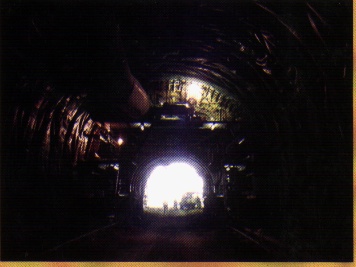
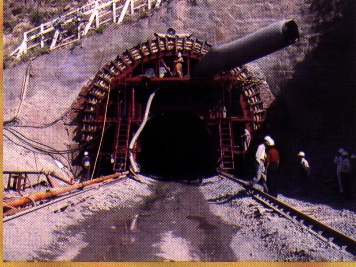
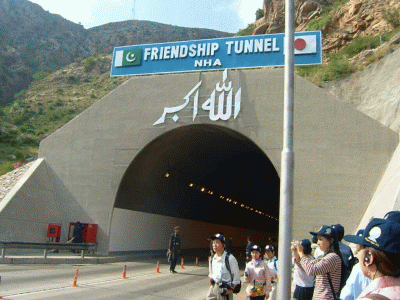
Making and Opening of the Tunnel
The tunnel is about 1.9 kilometres long and its construction began in 1999, and was opened to the public in June 2003. As part of the developing Indus Highway system, the tunnel serves as a shorter, alternate route to the Kohat Pass, situated between the cities of Peshawar and Kohat. The new route decreases the time required to travel through the Kohat Pass from three hours to less than one hour. Also, the tunnel will enable the passage of large vehicles, alleviate traffic congestion, improve traffic safety, and promote economic development. Since it has been built with the active involvement of the Japanese government, it is also referred to as the "Friendship Tunnel". Recently, the Pakistan Postage issued a commemorative stamp for the celebration of 50 years Pak-Japan friendship, showing Kohat Tunnel as one of the biggest projects ever undertaken by Japan in Pakistan.
Lowari Tunnel Project: Chitral - the land of Shandur and the Kafirs is located beyond a very difficult mountain top, the Lowari Top at 10,230 feet, which makes it almost inaccessible to reach Chitral for good about six months in winters, from late November to late May every year, due to snow fall. In winters, one has to enter Afghanistan from down Kunar River and then re-enter Pakistan to evade the snow covered top. Thus the only link with Chitral is through air. Therefore, a plan to build a tunnel cutting through its way from the Lowari Pass was conceived in the 1970s. The work began on the 8.8 kilometers long tunnel in 1977 but was then stopped at just 100 feet for paucity of funds and lack of sponsors from abroad. With the building of the tunnel, the 12-14 hours journey from Peshawar to Chitral is not only likely to be reduced to half but would also ensure a safe and open passage to Chitral throughout the year. The tunnel also serves strategic purposes, both economically and militarily.
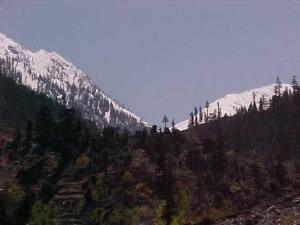
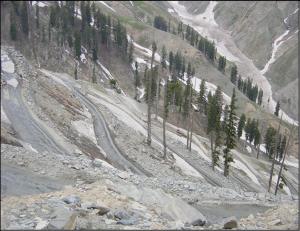
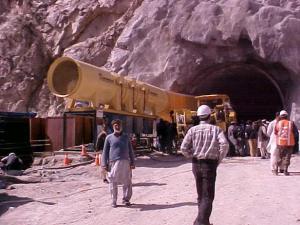
Left to Right: Lowari Top - The treacherous Zigzagged way to Lowari - The abandoned work
The plans for the revival of the tunnel work have recently been undertaken by the government of Pakistan and a South Korean company has been assigned the work on the tunnel, which is scheduled to start in October 2006. It is expected to be completed in three years at a cost of Rs.8 billion ($133 million US). It will be Asia's largest tunnel, according to local media reports. Lately there has been a revision in the plan and now instead of a road, a railway link will be established through the tunnel as a wide road will cost much more than simply a railway line.
Some of the other major highways which have either been completed or are under construction are:
-
The N-5: N-5 carries 60 % of entire traffic of the country. It is the life line of Pakistan. 80 % of economic activity is being carried out through it. N-5 is the longest Highway having length 1756 Km. It connects Karachi to Torkham via Multan, Lahore, Rawalpindi and Peshawar.
-
Indus Highway: Indus Highway is vital not only for defense of the country but also to open up West Bank of river Indus to greater economic activity. This project was conceived in early seventies but was abandoned in 1978. The Government is now giving higher priority to this project. Under Phase I & II, work on ten contracts covering a length of 823 kilometers of the Highway has been awarded. Under Phase III, remaining sections covering about 400 km and Kohat Tunnel will be taken up. Loan negotiations with OECF of Japan for Kohat Tunnel have been finalized. Contracts for these works will be awarded during 1994.
-
Karachi Khuzdar-Quetta Chamman Road: To materialize higher priority to infrastructure in Balochistan, the Government has provided larger funds to this project. Apart from benefiting the people of the province, this road provides the shortest route for Karachi port to Central Asian States. At present, it is a narrow road of low specifications. To cater for the heavy traffic, widening and improvement of this road has been taken up by the Government. Work on 308 km costing Rs. 2.77 billion has already been awarded.
-
Quetta-Dalbandin-Naukundi-Taftan Road: This road which provides the main link to Iran is narrow and of low specifications. The Government has accorded top priority to this project. The missing link between Nankundi and Taftan (124 km) has been completed. Improvement of 168 km of road between Dalbandin-Nankundi costing Rs. 1986 million is in hand.
-
Ratodero-Khuzdar Expressway: Contract for the construction of Ratodero-Shahdadkot-Quba Said Khan section (64 km) of the above Expressway has been awarded. The work is in progress. This Expressway will ultimately be linked with Gwadar Port. The feasibility study and design work of Gwadar-Khuzdar section is also nearly complete. This Expressway will provide a direct access to the port of Gwadar for Balochistan, Sindh and Punjab provinces. With the construction of this modern highway, Central Asian Republics will be able to use the deep-water port of Gwadar.
-
Sukkur Bridge and Bypass: National Highway N-5 and N-65 are linked by the Sukkur Barrage Road Bridge which is very narrow and not suitable for heavy traffic. In order to cater for the increasing volume of traffic, a new bridge down-stream of the Barrage along with Sukkur By-pass has been ordered at a cost of US $ 40 million. Negotiations are at advanced stage with Asian Development Bank.
-
Tall-Parachiner Road: For the development of Federally Administrated Tribal Areas, the Government has accorded high priority to the completion of Tall-Parachinar road. Rs. 100 million have been allocated during 1994-95 for the completion of this road. The Prime Minister has also directed to extend this road upto Afghanistan border.
The Motorways:
- M1 is from Islamabad to Peshawar. It is a 155 km access-controlled motorway with 6 lanes.
- M2 is from Lahore to Islamabad. It is a 367 km access-controlled motorway with 6 lanes. It was completed in November 1997.
- M3 is from Pindi Bhattian to Faisalabad. It is a 53 km access-controlled motorway with 4 lanes, which, in future, can be increased to 6 lanes.
- M4 is from Faisalabad to Multan with a total length of 200 km. It has 4 lanes, which, in future, can be increased to 6 lanes.
- M5 is from Multan to Dera Ghazi Khan with a total length of 65 km and 4 lanes, which, in future, can be increased to 6 lanes.
- M6 is from Dera Ghazi Khan to Ratodero with a total length of 450 km and 4 lanes, which, in future, can be increased to 6 lanes.
- M7 is from Kakkar via Dureji to Karachi with a total length of 303 km and 2 lanes.
- M8 is from Gwadar to Ratodero with a total length of 1072 km and 2 lanes.
- M9 is from Karachi to Hyderabad with a length of 136 Km and 6 lanes.
- M10 is the Karachi Northern Bypass, which has a total length of 56 km and 6 lanes.
PTCL's Nation Wide Dialing (NWD) Codes
|
|
Pakistan's Time Zone Difference
| Countries | Time Difference (Hours) | Countries | Time Difference (Hours) |
| Abu Dhabi | -1 | Lebanon | -3 |
| Afghanistan | -1/2 | Libya | -3 |
| Albania | -4 | Liberia | -5 |
| Austria | -4 | Malawi | -3 |
| Algeria | -4 | Malta | -3 |
| Australia | +5 | Mexico | -11 |
| Bahrain | -2 | Morocco | -5 |
| Bangladesh | +1 | Malaysia | +21/2 |
| Belgium | -4 | Mozambique | -3 |
| Barbados | -9 | Muscat | -1 |
| Brazil | -8 | Nepal | +1 |
| Bulgaria | -3 | Netherlands | -4 |
| Burma | +11/2 | New Zealand | +7 |
| Canada | -10 | Norway | -4 |
| Cape Verde Island | -7 | Nigeria | -4 |
| Chili | -8 | Pakistan | PST |
| China | +3 | Panama | -10 |
| Colombia | -10 | Paraguay | -9 |
| Cuba | -10 | Peru | -10 |
| Cyprus | -3 | Philippines | +3 |
| Costa Rica | -1 | Poland | -4 |
| Czech Republic | -4 | Portugal | -5 |
| Denmark | -4 | Ras-al-Khaima | -1 |
| Doha | -1 | Romania | -3 |
| Dubai | -2 | Saudi Arabia | -2 |
| Egypt | -3 | Somalia | -2 |
| Ethiopia | -2 | Sharjah | -1 |
| Fiji | +7 | Singapore | +2 1/2 |
| Finland | -3 | South Africa | -3 |
| France | -4 | Spain | -4 |
| Germany | -4 | Sri Lanka | +1/2 |
| Ghana | -3 | Sudan | -3 |
| Gibraltar | -4 | Sweden | -4 |
| Greece | -3 | Switzerland | -4 |
| Hungary | -4 | Syria | -3 |
| Hong Kong | +3 | Tanzania | -2 |
| Ireland | -4 | Thailand | +2 |
| Iceland | -5 | Tunisia | -4 |
| India | +1/2 | Turkey | -2 |
| Indonesia | +2 | U.S.A | +10 |
| Iran | -1 1/2 | Uganda | -2 |
| Iraq | -2 | U.A.E | -1 |
| Italy | -4 | U.K. ( GMT ) | -5 |
| Japan | +4 | U.S.S.R (Russia) | -2 |
| Jordan | -3 | Venezuela | -9 |
| Kenya | -2 | Zambia | -3 |
| Korea ( South ) | +4 | Zimbabwe | -3 |
| Kuwait | -2 |
--
میرا نیا بلاگ - اپنی رائے کا اظہار کیجئے
http://shoaibtanoli.wordpress.com/
Regards
M Shoaib TaNoLi
Karachi Pakistan
Email@ shoaib.tanoli@gmail.com
Cell # +92-300-2591223
Facebook :https://www.facebook.com/mtanoli
SKYPE: shoaib.tanoli2
پاکستان زندہ باد ۔ پاکستان پائندہ باد
Long Live Pakistan
Pakistan Zindabad!
Dear Readers: My mails are my personal choice. The purpose of these mails is to establish contact with you, make you aware of different cultures ,disseminate knowledge and information. If these (mails) sound you unpleasant, please intimate .
IF YOU ARE NOT INTERESTED IN MY MAIL
PLEASE REPLY THIS E_,MAIL WITH THE SUBJECT.. UNSUBSCRIBE
E Mail: shoaib.tanoli@gmail.com
--
پاکستان کسی بھی پاکستانی کے لئے اللہ کی سب سے بڑی نعمتوں میں سے ایک ہے. آج ہم جو بھی ہے یہ سب اس وجہ پاکستان کی ہے ، دوسری صورت میں ، ہم کچھ بھی نہیں ہوتا. براہ مہربانی پاکستان کے لئے مخلص ہو.
* Group name:█▓▒░ M SHOAIB TANOLI░▒▓█
* Group home page: http://groups.google.com/group/MSHOAIBTANOLI
* Group email address MSHOAIBTANOLI@googlegroups.com
To unsubscribe from this group, send email to
MSHOAIBTANOLI+unsubscribe@googlegroups.com
*. * . * . * . * . * . * . * . * . * . *
*. * .*_/\_ *. * . * . * . * . * . * . * . * .*
.•´¸.•*´¨) ¸.•*¨) ¸.•´¸.•*´¨) ¸.•*¨)
(¸.•´ (¸.•` *
'...**,''',...LOVE PAKISTAN......
***********************************
Muhammad Shoaib Tanoli
Karachi Pakistan
Contact us: shoaib.tanoli@gmail.com
+923002591223
Group Moderator:
*Sweet Girl* Iram Saleem
iramslm@gmail.com
Face book:
https://www.facebook.com/TanoliGroups
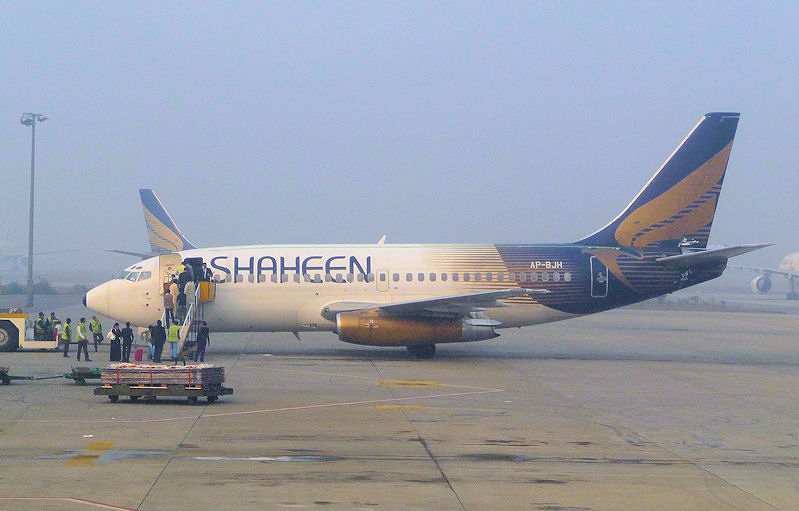



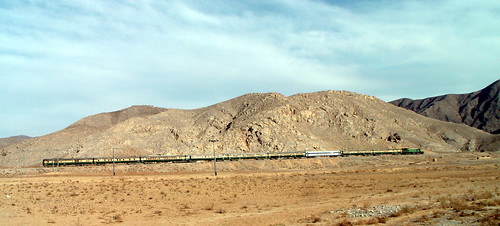

It is really a nice and helpful piece of information. I’m glad that you shared this useful information with us. Please visit my web site babyiconic.co.uk
ReplyDeletewreckers near me
I can only aspire to write material like this. I am extremely impressed with your presentation of the sound points in this article. Thank you for writing this engaging content.
ReplyDeleteXLi for rent in Islamabad